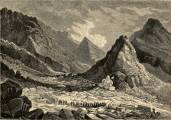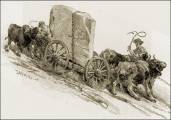


Calaveras County
- Calaveras County – List of Stone Quarries, Etc.
- Calaveras County Marble and Trachytic Tuff (historical to circa 1906) – Excerpt from The Structural and Industrial Materials of California, Bulletin No. 38, California, State Mining Bureau, San Francisco, California, 1906.
- Calaveras County Mines and Mineral Resources (circa 1913-1914) - Excerpts from Report XIV of the State Mineralogist - Mines and Mineral Resources of Portions of California, Chapters of State Mineralogist's Report - Biennial Period 1913-1914, Part I. “The Counties of Amador County, Calaveras County, Tuolumne County,” by W. B. Tucker, Field Assistant, San Francisco, California, July, 1915, 1916.
- Calaveras County Mineral Industry (circa 1919) - Excerpt from California Mineral Production for 1919, Bulletin No. 88, by Walter W. Bradley, California State Mining Bureau, 1920.
-
Calaveras County Limestone Industry
and Deposit (through 1947) - Excerpts from “Limestone in
California,” by Clarence A. Logan, California Journal
of Mines and Geology, Vol. 43, No. 3, July 1947,
California Division of Mines, San Francisco,
California.
-
Calaveras County
Marble and Trachytic Tuff (historical to circa 1906) -
Excerpts from The Structural and Industrial Materials of
California, Bulletin No. 38, California, State Mining
Bureau, San Francisco, California, 1906.)
“White, gray, and banded marble is found in many places in Calaveras County, but is not quarried. The belt passes from Tuolumne County northward through Calaveras County, and is found near Vallecito, Murphys, and Cave City. (See also XIIth Report of California State Mining Bureau, page 391.)”
(Volcanic and Intrusive Rocks) “Several quarry faces have been opened at different times on the steep cliff on the north side of the lower road to Murphys (by Vallecito), about 2 miles northeast of Angels, in Sec. 26, T. 3 N., R. 13 E. The stone is a trachytic tuff and can be obtained in any desired amount, but no very large dimension stone can be quarried because of the numerous seams and cracks.”
-
Calaveras County, Mines and Mineral Resources (circa 1913-1914) - Excerpts from Report XIV of the State Mineralogist - Mines and Mineral Resources of Portions of California, Chapters of State Mineralogist's Report - Biennial Period 1913-1914, Part I. "The Counties of Amador County, Calaveras County, Tuolumne County," by W. B. Tucker, Field Assistant, San Francisco, California, July, 1915, California State Mining Bureau, San Francisco, California, 1916, pp. 2-172.)
Introduction
"Calaveras County is bounded on the north by Amador, on the east by Alpine, on the southeast and south by Tuolumne, on the southwest and west by San Joaquin County.
"The Mokelumne River, on the northwest, separates Calaveras from Amador County, while the Stanislaus, on the southeast, separates Calaveras from Tuolumne. It is the central one of the Mother Lode counties, and it is centrally located relative to the entire auriferous slate belt of the Sierra Nevada slope.
"All physical conditions are favorable to mining, there being an abundant supply of timber and water. The county is richly mineralized throughout, presenting several belts and districts.
"The Mother Lode crosses the county along a thirty-mile course, and in this county displays the characteristics of vast bodies of low and medium grade ore, presenting mining propositions of the sort now especially attractive to conservative mining capital. On this lode, at the northern side of the county, is the noted Gwin mine; by the southern boundary is the Melones, one of the largest mining properties in the State, and between them is the Angels Camp group of mines consisting of the Utica group, one of the ranking gold mines of the country, also the Angels and Lightner mines; with other important mines intermediate along the lode.
"The east and west belts are noted for gold resources, which are now (circa 1914) attracting marked attention. The auriferous gravel deposits of the ancient river channels aggregate over fifty miles in length, and there has been an increased activity in placer mining in these channels, especially in the neighborhood of Mokelumne Hill, which camp promises to be a large gold producer again.
"Three dredges are under active operation on the Calaveras River near the town of Jenny Lind, another dredge is in operation on the Mokelumne River near Comanche, and active prospecting operations are under way to open up new dredging ground on both these rivers.
"Besides being notably rich in gold, Calaveras possesses large and valuable copper mines, and deposits of clay, iron ore, limestone, marble and sandstone.
Railway Facilities (in Calaveras County)
"The county has the advantage of direct communication with the principal trade centers by means of railroads, which enter the county at three different points - on the north at Valley Springs, farther south at Milton, and on the extreme southern end at Melones. From the different railway points there are good automobile roads to the mining districts.
Mineral Resources (in Calaveras County)
"The mineral resources of Calaveras County consist of asbestos, chrome, clay, copper, gold, limestone, marble, mineral paint, mineral water, platinum, pyrite, quartz crystals, stone industry and silver."
Marble (in Calaveras County)
"The Columbia area of limestone which is exposed in the neighborhood of Vallecito, Douglas Flat, and Murphy, is extremely irregular, having a general strike of northwest and southeast. Most of the limestone, although retaining a distinct bedded and schistose structure, has become a granular crystalline rock to which the name marble is applicable. When polished it is generally nearly white, marked by faint gray veinings and is rather fine grained. A small amount of development has been done on these deposits, but the quarries are idle due to their distance from transportation (circa 1914).
"In the neighborhood of Murphy, east of Mokelumne Hill, and near San Andreas, there are extensive marble deposits which are undeveloped on account of the lack of transportation facilities."
Slate (in Calaveras County)
"Running through Calaveras County there is a great belt of black slate, having a northwesterly and southeasterly course, and which has been exploited to some extent near Tower's Ranch, 2 miles west of Cooperopolis, on the Copperopolis and Oakdale road."
The following information is taken from the table on the insert page after page 54 entitled, "Calaveras County - Table of Mineral Production."
Limestone Production in Calaveras County:
1904: Lime, 3,500 bbls.; Value: $5,500.
1905: 3,087 tons; Value: $15,430.
1906: 3,994 tons; Value $7,635.
1907: 6,872 tons; Value: $16,955.
1908: 14,165 tons; Value: $31,446.
1909: 4,590 tons; Value $11,987.
1910: 6,283 tons; Value: $16,976.
1911: 3,943 tons; Value: $11,733.
1913: 2,000 tons; Value: $1,400.
Lime/Limestone Totals: 44,934 tons; Value: $119,062.Total Mineral Production, 1880 to 1913, Inclusive:
Lime: $5,500
Limestone: $113,562. -
Calaveras
County Mineral Industry (circa 1919) - Excerpt from
California Mineral Production for 1919, Bulletin No.
88, by Walter W. Bradley, California State Mining Bureau,
1920, pp. 144.
Area: 1,027 square miles.
Population: 6,183 (1920 census).
Location: East-central portion of state - Mother Lode district."Calaveras County reported production of 8 different minerals, valued at $1,886,608 during the year 1919, as compared with the 1918 output at $2,794,452. Gold, copper and silver are the chief mineral substances produced. In regard to total value of mineral output Calaveras stands seventeenth among the counties of the state; it is fifth in gold, third in copper, fifth in silver, having been passed by Plumas in copper and silver output for 1918-1919, and by Kern in silver, 1919. The decrease, as compared with 1918, is due to gold and copper.
"The principal mineral resources developed and undeveloped are: asbestos, chromite, clay, copper, fuller's earth, gold, limestone, marble, mineral paint, mineral water, platinum minerals, pyrite, quartz crystals, silver, soapstone, and miscellaneous stone.
"Commercial output for 1919 was as follows:"
(Headings for the information below are: Substance, Amount, and Value.)
Cooper, 2,049,330 lbs., $381,175
Gold, ---, $1,410,000 (estimated)
Lead, 2,019 lbs., $107
Mineral Water, 4,384 gals., $1,034
Platinum, 8 oz., $1,076
Silver, ---, $84,500 (estimated)
Stone, miscellaneous, ---, $600
Other minerals,* ---, $8,116
(Total value) $1,886,608 -
Calaveras County Limestone Industry and Deposits (up through 1947) - Excerpts from "Limestone in California," by Clarence A. Logan, California Journal of Mines and Geology, Vol. 43, No. 3, July 1947, California Division of Mines, San Francisco, California, pp. 175-357. Used with permission, California Department of Conservation, California Geological Survey.)
"Although the limestone resources of this county are immense, the only large development has been that of Calaveras Cement Company. The great Columbia marble belt, which extends for miles across Tuolumne County, is over 3 miles wide when it enters Calaveras County at the North Fork of Stanislaus River. It extends from there over an area of about 15 square miles. About a quarter of this was covered by flows of andesite tuff, latite, and rhyolite which mantled old gold-bearing gravel. The mining of the gravel exposed the old eroded limestone bedrock at Douglas Flat and Murphy, similar to that around Columbia. In elevation, the limestone extends from a little below the 1000-foot contour at the river to the 2000-foot contour near Douglas Flat, and 2200-foot contour at Murphy. So, while the conformation of the rocks on which it rests is unknown, the total volume must be stupendous. In general, it is similar in appearance and would probably prove similar in composition to the limestone and marble in the same belt in Tuolumne County. Some of it is highly magnesian, and careful examination and sampling would probably reveal the same wide variation from high-calcium limestone to dolomite in adjacent bands.
"Attempts were made in the past to open marble quarries at places in this large deposit. This was during the years when Angels Camp, 5 miles west of the main marble belt, had railroad service over a branch of the Sierra Railroad from Sonora via Melones. This service was ended and the rails removed several years ago. The nearest railroad points now are at Kentucky House about 15 miles by road northwest of Vallecito, and Sonora, 15 miles south. There has been no activity at these marble quarries in the past 20 years. Other marble deposits in the vicinity of San Andreas and on Bear Mountain, have also remained idle.
"In the western part of the county between Valley Spring and Paloma and within a short distance over good roads from the railroad at Valley Spring, there are several small limestone deposits which were worked to furnish flux for the Campo Seco copper smelter, but this has been idle about 20 years. Their favorable location might permit the use of some of this stone by consumers looking for small tonnage."
Marble Deposits (in Calaveras County)
"Most of the limestone in the county has been changed to marble, and there is an immense amount of it available. As the principal body is the north portion of the large marble outcrops extending northward from Columbia, Tuolumne County, where there has been a large production of high-quality marble, there is no doubt that the marble in Calaveras County would be found to be of high quality also. The places mentioned below* are only those where there has been some record of past activity. There are probably other possible quarry sites in the Murphy and Vallecito districts."
(* Please note that the marble quarries mentioned in the above paragraph are listed according to their location in the list of quarries in the section below entitled, "Calaveras County List of Stone Quarries, etc.")
Commercial use of material within this site is strictly prohibited. It is not to be captured, reworked, and placed inside another web site ©. All rights reserved. Peggy B. and George (Pat) Perazzo.

